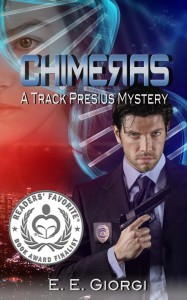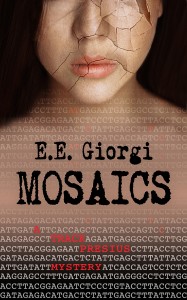Combining Genetics, Photography, and the Power of Smell: E.E. Giorgi Answers Her Muse
I’m not a huge traditional detective mystery reader. I’ve never read many hard-boiled or police procedural novels. But then this book, Chimeras, caught my eye. E.E. Giorgi, a scientist, writer, and photographer, managed to combine elements of science fiction and detective stories into a captivating novel that will titillate the senses. Seriously. I’ve never read a novel that evoked so many different olfactory responses. But it all makes perfect sense when you dive into epigenetically-altered Track Persius and his predatory instincts as a detective. It’s also one of the reasons E.E. Giorgi’s Chimeras just became a Reader’s Favorite Book Award Finalist. You’ve got to at least check out the blurb and give the book a spin for yourself. E.E. combines genetics, biotechnology, and mystery into a single package that reads like a sensory roller coaster. And, if that’s not enough, you can get a taste of here fantastic photography here: http://elenaedi.smugmug.com/ For more talk on books, science, and everything-in-between, take a peek at her blog: http://chimerasthebooks.blogspot.com/ If you don’t get too distracted by those awesome sites, E.E. answered a couple of questions regarding her scientific and artistic endeavors. Check it out!
Can you tell us a little about your scientific work?
I’m a computational biologist, which means that instead of doing biology in a wet lab, I sit at my desk and crank numbers (= I analyze data from experiments) on a computer. Most of my work focuses on HIV vaccine design, but I also have side projects on human genetics, where we look at associations between diseases and particular sites in the human genome. How does that inspire your writing? It inspires most of my writing! And I don’t mean just my research, but all of the cool science I come across at work. When I go to seminars, I often find myself thinking, “Whoa, what if humans could do that instead of just bacteria?” Or: “How will people use such concept one hundred years from now?” That’s how I got the idea for my first book, Chimeras. I learned about pseudogenes — inactivated genes that we inherited from our ancestors — and I asked myself: “What if pseudogenes that once coded for predator traits suddenly reactivated in a person?” I probably shouldn’t say this, but the environment also inspires me. I see “battles for turf” just like in any other field, only in this case the “turf” consists of ideas, patents, grant money. It’s kind of sad, but it’s also very real. Just because we are scientists, it doesn’t mean that we treat everything objectively.
And, does your writing ever inspire your science? Are there translatable skills between the two areas of your life?
That’s an interesting question. I don’t think it inspires my science, but I do believe it helps when I have to write a manuscript. Even though writing a paper involves a completely different set of skills than writing a novel, I still try to keep in mind some kind of “plot” that leads the reader from the overview of the question we are addressing to the main results and conclusions.
different set of skills than writing a novel, I still try to keep in mind some kind of “plot” that leads the reader from the overview of the question we are addressing to the main results and conclusions.
Ah, yes. It’s always refreshing to pick up a scientific manuscript that tells a “story” through research. In addition to your science and writing, we can’t forget about your photography! How does that fit in?
I picked up photography while Chimeras was on submission through my agent. I had no idea it would become such a huge part of my life, so much so that I often feel it competes with writing. When I’m working hard on a story I try not to think about photography as it can be very distracting, but every now and then an idea for a new image will pop in my head and I’ll have to drop everything and go shoot. Interestingly, photography has made me fully aware of the light around me. I noticed that now, whenever I start a new scene, the lighting is the first thing that comes to mind: how it falls on faces, how it colors the landscape, and, most importantly, how it sets the mood. A warm light (i.e. pink/orange, as in a sunset, for example) is usually cheerful and happy. But if I have a tense scene, full of action, I go for cold lights, for example blue halogen bulbs, or the artificial illumination from a secluded street. It’s fun to fold all this in.
That’s a fascinating perspective on applying visual detail to your writing. How do you manage to balance these three passions in your life?
I’m afraid I don’t manage it very well. My work and family of course come first. After all, I do science for a living, and I enjoy it very much, so that has to be my priority. Like I said earlier, photography happened sort of in between things, and sometimes I feel like it’s distracting me from more important things. But I confess it’s truly rewarding to have people look at my pictures and recognize the emotions I’m trying to convey. It’s a lot harder to trigger the same feelings through the written word, and sometimes, when I get stuck or frustrated with my writing (I have a tendency to paint myself into corners), it’s good to have a distraction. So, to answer your question, science comes first, next comes the muse, whether she makes the call for a new story or a new image. 🙂
One tantalizing aspect of Chimeras was the absolute sensory experience the book provides because of Track’s epigenetic mutations. What inspired Track’s conditions? And how did you get in the mindset of describing him as a predator with heightened sense (especially when it came to the smells, both alluring and appalling to Track)?
Thank you! I’m always ecstatic when I hear from readers that they’ve enjoyed the “olfactory” part of the book. Track was born from a mix of things. I was intrigued by the idea of a “creature” that can love and kill at the same time. I picked up a vampire book because of this concept, but I was hugely disappointed. I thought that the book failed in exploiting the “scary” part of the creature. However, even though I didn’t enjoy that particular book, I kept thinking about the story and how I would’ve improved where the author (in my opinion) had failed. Around the same time, I learned about pseudogenes, the inactivated genes I mentioned before. Here’s the cool thing: every time a new species evolves from an old one, it still retains the “old” genes, only, they’re no longer activated. Take the vomeronasal organ for example: many mammals use it to smell pheromones. We still have the vomeronasal organ, but of course we no longer use it since humans today rely more heavily on visual stimuli rather than olfactory ones. Similarly, we share pseudogenes with most of our ancestors: monkeys, lions, wolves, etc. With every genome, comes also a set of “instructions” on which genes are to be used (activated) in which cells. These “instructions” change from person to person, but they can also change throughout life. A trauma, for example, or a bad diet can make some genes switch off and others turn on. So, I put all these cool concepts together and thought: what if there was one human being whose ancestral (predator) genes, for whatever reason, were suddenly turned on? I discussed these ideas with my dad, who’s a developmental biologist, and he told me that most pseudogenes in the human genome code for olfactory receptors, and that, oddly, olfactory receptors can be found in the strangest places, not just in the nose. Males have them in sperm. We all have them in our guts. So, if my character were to have activated pseudogenes, he had to have an enhanced sense of smell. And then I thought that somebody with an enhanced sense of smell would be perfect at finding bodies and solving crimes. At that point I had the science down, I just had to learn all about police work and forensics. But that’s another story. 🙂
Around the same time, I learned about pseudogenes, the inactivated genes I mentioned before. Here’s the cool thing: every time a new species evolves from an old one, it still retains the “old” genes, only, they’re no longer activated. Take the vomeronasal organ for example: many mammals use it to smell pheromones. We still have the vomeronasal organ, but of course we no longer use it since humans today rely more heavily on visual stimuli rather than olfactory ones. Similarly, we share pseudogenes with most of our ancestors: monkeys, lions, wolves, etc. With every genome, comes also a set of “instructions” on which genes are to be used (activated) in which cells. These “instructions” change from person to person, but they can also change throughout life. A trauma, for example, or a bad diet can make some genes switch off and others turn on. So, I put all these cool concepts together and thought: what if there was one human being whose ancestral (predator) genes, for whatever reason, were suddenly turned on? I discussed these ideas with my dad, who’s a developmental biologist, and he told me that most pseudogenes in the human genome code for olfactory receptors, and that, oddly, olfactory receptors can be found in the strangest places, not just in the nose. Males have them in sperm. We all have them in our guts. So, if my character were to have activated pseudogenes, he had to have an enhanced sense of smell. And then I thought that somebody with an enhanced sense of smell would be perfect at finding bodies and solving crimes. At that point I had the science down, I just had to learn all about police work and forensics. But that’s another story. 🙂
Sounds like a lot of great research went into Track’s first book. Now, you have two new books coming out. One, Mosaics, follows Track again. Can you give us some teasers on how science plays a part in this book? And what new scents does Track come to love and hate?
I’m very excited about Mosaics, Track’s next adventure. I’ve had some terrific feedback from my early readers and I can’t wait to release it to the public. The scientific theme in Chimeras was gene therapy and how things can go wrong when you mix profit and research. In that aspect, Mosaics is somewhat similar, but the scientific theme this time is HIV research and the quest for a vaccine. As for scents… Hmm, I don’t want to give away any spoilers. Let me just say that in Mosaics, Track and his partner are after a serial killer who leaves mosaic tiles next to his victims — hence the name “Byzantine Strangler.” Needless to say, these tiles have a very unique scent, but it won’t be until much later in the book that Track will come to identify it…
Can you tell us a li ttle about Gene Cards as well? How does this series compare to Track’s? I’m particularly intrigued by your use of Gene Cards because I was similarly inspired by the idea that our genes might be the future key to identification (featured in one of my series as the Chip). Do you see this as plausible future? Something we should be thinking about now?
ttle about Gene Cards as well? How does this series compare to Track’s? I’m particularly intrigued by your use of Gene Cards because I was similarly inspired by the idea that our genes might be the future key to identification (featured in one of my series as the Chip). Do you see this as plausible future? Something we should be thinking about now?
It took many years to sequence the full human genome. And once that was achieved, in a comparably short time, sequencing human DNA became not only wide spread, but also very affordable. Now with only $99 you can find out your ancestry through 23andMe [www.23andme.com]. Affordable, though, doesn’t mean that we fully understand what every base in the human genome means. We don’t, in fact, and that’s the part that actually scares me. More and more people advocate for sequencing every individual on the basis that it could lead to better health care and prevention. What they don’t understand is that genes don’t work like switches. You might tell a woman that she’s fine because she doesn’t have the BRCA mutations, yet 80% of the women who develop breast cancer don’t have them. Or, you might convince her to get a mastectomy because she does have the BRCA mutations, when 40% of women with those mutations do not develop breast cancer. The genetic associations found so far only explain 10% of the heritability of those diseases. Every individual is unique and, as such, unpredictable. There are too many layers of complexity that go from DNA to RNA to proteins that even after all these years we are still only scraping the surface of the iceberg. So, if we were really to genotype every person for health care purposes, not only we would risk to overwhelm people with information we can’t fully understand, but there’s an additional danger to this scenario: What if the information gets in the wrong hands? What if health insurance companies start refusing coverage based on one’s genome? What if employers start discriminating people based on their DNA? These are the questions that prompted me to create the world of Gene Cards, a near-future sci-fi story set in a world where ID’s are based on DNA and invasive wi-fi technology tracks individuals everywhere. In a world like that, hackers would be the outlawed but also the heroes, wouldn’t they?
Thank you very much for the interview. Is there anything else you’d like to tell the readers?
Thank you so much for having me over at your blog, Anthony! Yes, I would like to tell readers who love cool science facts and stories with plausible science to follow my blog (http://chimerasthebooks.blogspot.com/p/books.html) and/or subscribe to my newsletter (eepurl.com/SPCvT) to get free desktop wallpapers (from my photography gallery) and notifications on forthcoming books. Thanks!

Thanks so much for the great interview, Anthony!
I just realized that I didn’t fully answer your question on Gene Cards, so let me add a little bit: the book features Muay Thai fighter and Biothreat Agent Skyler Donohue, computer hacker and most wanted criminal Yulia Szymanski, and extravagant, paranoid medical examiner Erasmus Montoya. How’s that for an eclectic brood? 🙂
Even though it’s still a mystery, the book diverges quite a lot from the Track Presius series. I originally had in mind to set it here in the Southwest, but then I got tired of editors reading my book and rejecting it based on the fact that it was neither a mystery nor a sci-fi. So I decided to set Gene Cards in the future so that there wouldn’t be any doubt about it being a sci-fi book. So, while for Chimeras I researched the Los Angele Police Department and went scouting locations throughout Orange County, with Gene Cards I had a lot of fun researching state-of-the-art technology that one day will be part of our every day household. And some, of course, I totally made up, which was also a lot of fun. 🙂
Thanks again for the opportunity!